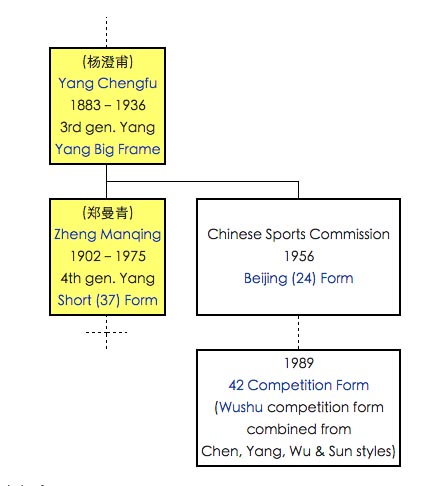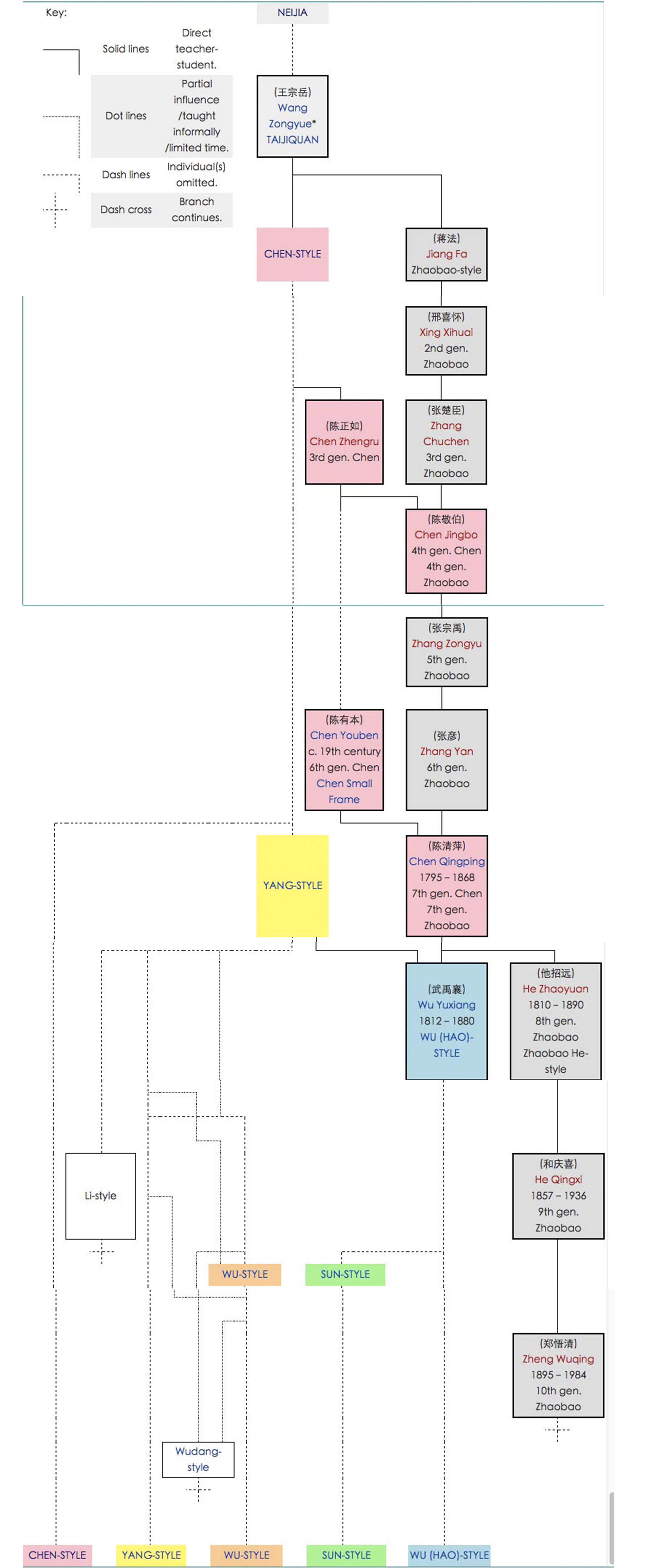Tag: tradition
Taichi Ball rotation exercise
Taichi style tree – ( why I choose 24 forms of yang style)
1. How did Tai Chi begin?
There are two theories
- Theory #1
- Around the Yuan and Ming Dynasty – Chang Sanfeng – about 600-700 years ago lived in Shaolin Temple and went to WuDang Mountain and created Tai Chi. He saw a crane fighting with a snake. The crane was always hard. The snake would yield and follow the crane and did not resist and so he didn’t lose his life to the crane. Hard was controlled by soft.
- Theory #2
- Created by Chen Family about 300 years ago by Chen Wangting.
2. What are the 13 Postures (original name of Tai Chi Chuan)?
The 13 Postures are comprised of 8 energies and 5 steps:
8 energies are: ward off, roll back, press, push, pull, elbow strike, shoulder strike, and split
5 steps are: forward, back, look left, gaze right, and center
3. How many styles of Tai Chi are there and what are their differences?
There are 5 different styles of Tai Chi that are connected with each other. Chen, Yang, Wu, Wu and Sun styles. All 5 styles are connected together; their outside movements are a little different but inside the energies are the same.
Chen Style – is fast and slow combined together with some jumping and stomping movements. Old form and cannon fist was created from the 17th generation.
Yang Style – Yang Luchan learned the old form/frame from the Chen family. Yang movements are slow, even, gentle, big and large. Yang Luchan learned from the 14th generation Chen family member.
Wu/Hao Style – The 1st Wu style came from Yang and Chen styles and is slow, smooth, and small and the posture is high. Wu Yuxiang learned from Yang Banhou, 2nd generation Yang family member, and then learned from Chen Qingping, 14th generation. Wu/Hao is a smaller frame.
Wu Style – 2nd Wu style comes from Quanyu who learned from Yang Banhou. They lean their body to the side but when they lean they think about being straight. Wu learned from Yang Banhou. Later in age Banhou’s frame became smaller.
Sun Style – learned from Hao Weijian. Their movements combine 3 styles of Tai Chi together, Wu, Hsing-I and Bagua.
4. Who created each of the 5 styles?
Chen was created by Chen Wangting
Yang was created by Yang Luchan
Wu/Hao was created by Wu Yuxiang
Wu was created by Wu Jian Quan or Wu Quanyu
Sun was created by Sun Lutang
5. Who did the creators learn from?
Yang Luchan learned from Chen Changxin
Wu Yuxiang learned from Yang Luchan, Yang Banhou and Chen Qingping
Wu Jianquan learned from his father, Quanyu
Sun Lutang learned from Hao Weijian
6. The most practised form now.
The Beijing 24 Form was the result of an effort by the Chinese Sports Committee, which, in 1956, brought together four Taiji teachers – Chu Guiting, Cai Longyun, Fu Zhongwen, and Zhang Yu – to create a simplified form of Taiji as exercise for the masses. The creators truncated the traditional family style Taiji forms to 24 postures; taking about six minutes to perform and to give the beginner an introduction to the essential elements of Taijiquan, yet retain the traditional flavor of traditional longer hand forms (in general, 88-108 postures). Henceforth, this form was avidly promoted by the People’s Republic of China for general exercise, and was also taught to internees in Communist “re-education” camps. Due to this official promotion, the 24-form is most likely the Taiji form with the most practitioners in China and the world over.
source:
https://en.wikipedia.org/wiki/Yang-style_t%27ai_chi_ch%27uan
https://en.wikipedia.org/wiki/24-form_tai_chi_chuan
http://www.yangfamilytaichi.com/about/study/#history-01
simplified-yang style-24 hand forms
Beijing Form
| Chinese | Pinyin | English | |
|---|---|---|---|
| 1 | 起势 | qǐ shì | Beginning form |
| 2 | 野马分鬃 | yě mǎ fēn zōng | Wild horse, part the mane |
| 3 | 白鹤亮翅 | bái hè liàng chì | White crane, brilliant wings |
| 4 | 搂膝拗步 | lǒu xī ǎo bù | Embrace knee, twist step |
| 5 | 手挥琵琶 | shǒu huī pí pá | Hands play Pipa |
| 6 | 倒撵猴 | dǎo niǎn hóu | Retreat, expel the monkey |
| 7 | 左揽雀尾 | zuǒ lǎn què wěi | Left grasp the sparrow’s tail |
| 8 | 右揽雀尾 | yòu lǎn què wěi | Right grasp the sparrow’s tail |
| 9 | 单鞭 | dān biān | Single whip |
| 10 | 云手 | yún shǒu | Cloud hands |
| 11 | 单鞭 | dān biān | Single whip |
| 12 | 高探马 | gāo tàn mǎ | High pat the horse |
| 13 | 右蹬脚 | yòu dèng jiǎo | Right kick foot |
| 14 | 双峰贯耳 | shuāng fēng guàn ěr | Both hands strike ears |
| 15 | 左蹬脚 | zuǒ dèng jiǎo | Left kick foot |
| 16 | 左下势独立 | zuǒ xià shì dú lì | Left going down power, stand on one leg |
| 17 | 右下势独立 | yòu xià shì dú lì | Right going down power, stand on one leg |
| 18 | 玉女穿梭 | yù nǚ chuān suō | Jade woman works the shuttles |
| 19 | 海底针 | hǎi dǐ zhēn | Sea bottom needle |
| 20 | 闪通背 | shǎn tōng bèi | Fan through the back |
| 21 | 转身搬拦捶 | zhuǎn shēn bān lán chuí | Twist the body, deflect block, strike |
| 22 | 如封似闭 | rú fēng sì bì | Like closing (a door) |
| 23 | 十字手 | shí zì shǒu | Ten letter hands (cross hands) |
| 24 | 合太极 | hé tài jí | Gathering taichi |
Taichi fighting with wooden dummy
Tai Chi Chair Is A Dead Simple Exercise Chair
Treadmill too big to install in your home office? Here’s a space-efficient way to flex some muscles during 15-minute breaks: the Tai Chi Chair.
Designed by ESAD Reims student Yuan Yuan, the furniture sports handholds and footholds that allow you to perform a variety of exercises. I’m not too familiar with Tai Chi, though, so I don’t know about the name. Isn’t that the thing they do in the park with no equipment whatsoever?
The Tai Chi Chair is a dead simple seating chattel, with a wooden plywood seat and a small bar of cushion for the back. The rest of the chair consists of the metal frame, sections of which have been bent in various shapes for use in different gym-like exercises (some of which, by the way, look like a one-way ticket to a busted nose).
Hopefully, the furnishing comes with instructions, since most people will likely be stumped about what exercises to do on the thing. Plus, it’s probably a bad idea to use this as your actual working chair, since that bottom is flat and that back looks similarly uncomfortable. Best save this as a spare for the occasional guest.
Personally, I like the idea, but the furniture’s overall usability as an actual office chair will need to be addressed. Fortunately, the Tai Chi Chair is only a first version prototype that was intended for a proposed event (that, from what I can gather, didn’t push through, either).


